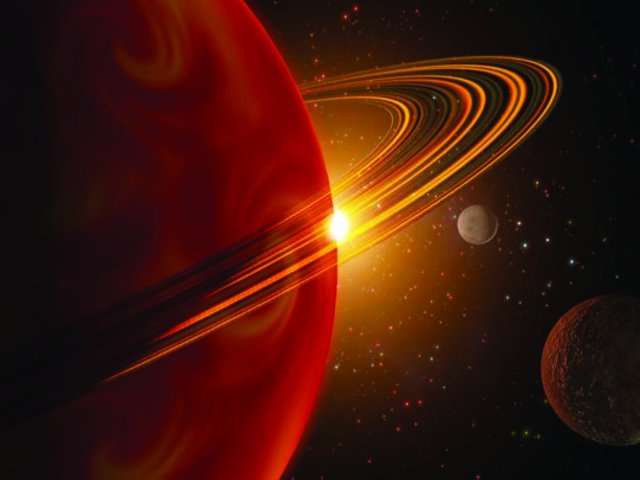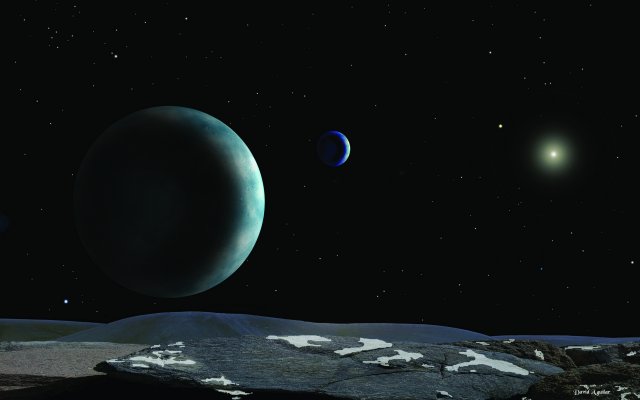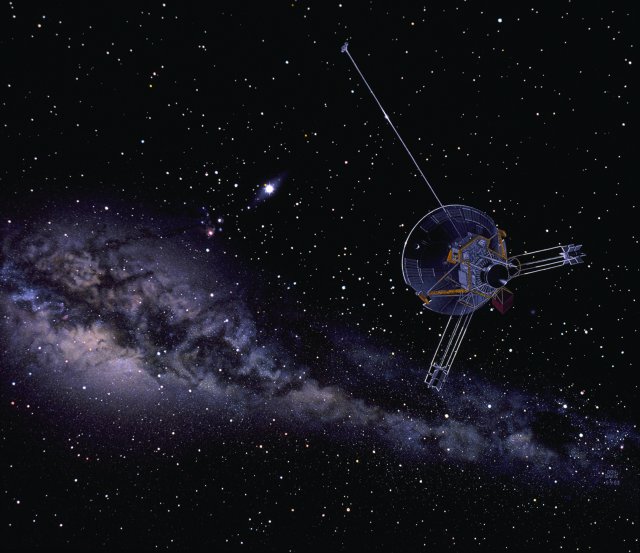|
Planet X:
What’s Going On In The Outer Solar System?
Before we proceed further, let’s take a potted
history of the solar system’s ‘back of beyond’... The term ‘Planet
X’ came about when astronomers were looking for a planet beyond the
orbit of Neptune. The ‘X’ simply meant ‘unknown’.
The first contender for the
term, though, was Uranus. For millennia, there were only six planets
sharing space: Mercury, Venus, Earth, Mars, Jupiter and Saturn. Of
course, our ancestors didn’t realize they were planets and called
them ‘wandering stars’, which is what ‘planet’ means. Their orbits
make them move quite quickly against the background stars, you see.
Although Uranus is sometimes just visible to the
naked eye, it wasn’t ‘officially’ discovered until Sir William
Herschel spotted it in 1781. Fifty-five years later, Neptune brought
the Sun’s planetary tally up to eight.
When Pluto was discovered in 1930 by Clyde Tombaugh,
we suddenly had nine planets orbiting the Sun, so the search for
Planet X became the search for the tenth planet. ‘X’ is ten in Roman
numerals, obviously.
For over seventy years, Pluto was held as the
outermost member of the Sun’s family, a tiny, rocky/icy body that
had an orbit like none of the other planets. Its orbit brought it
inside that of Neptune for several years and its orbit is at an
angle very different to that shared by its eight cousins. The other
eight planets orbit in what is called ‘the plane of the ecliptic’.
They all share this orbital slice of space within a few degrees of
each other. You might liken the solar system to a dinner plate, with
the Sun being a big baked potato in the middle and the planets
being, say, peas placed on the plate at regular intervals.
Pluto, though, is a pea that some naughty kid is
throwing at the plate from above. Its orbital inclination is
seventeen degrees from the ecliptic. Pluto was also much smaller
than expected, being only 2,390km (1,485 miles) in diameter. The
search for Pluto was sparked by an apparent eccentricity in the
orbit of Neptune. It seemed that something was tugging at the gas
giant and affecting its orbit. Pluto was way too small to have this
kind of an effect. It turned out that an error had been made and
Neptune was not being pulled by a massive body somewhere in the far
reaches of the solar system.
In 2006, there was a radical redefinition of what
constitutes a planet and Pluto got demoted to the status of a ‘minor
planet’. Loads of TNOs also fell into this category. So far, over a
thousand Kuiper Belt objects have been discovered and it is thought
there may be at least seventy thousand of them out there in the
dark, cold reaches of space where the Sun’s light is a tiny fraction
of what we have on Earth.
So, we’re down to eight planets in the solar system
again. But are we?
In February,
2008, speaking at the American Association for the
Advancement of Science (AAAS), NASA’s Alan Stern said, “Our old
view, that the Solar System had nine planets will be supplanted by a
view that there are hundreds if not thousands of planets in our
Solar System.” He went on: “It could be that there are objects of
Earth-mass in the Oort cloud but they would be frozen at these
distances. They would look like a frozen Earth.”
The Oort cloud is a theoretical region around the
Sun where comets are said to reside before being shunted into
closer, solar orbits by passing stars. It is much further out than
the Kuiper Belt, stretching perhaps a light-year out into space.
At the same meeting, it was declared that between
twenty and sixty percent of stars may have rocky planets orbiting
them. That’s a heck of a figure. If only a small percentage of those
planets fall into the so-called ‘Goldilocks Zone’, the region where
liquid water can form, then there may be literally billions of
life-bearing planets in our galaxy alone.
Anyway, back to Planet X…
We have seen that the outer solar system is more
heavily-populated than we could have imagined half a century ago. We
have also seen that Earth-sized bodies might be out there waiting to
be discovered.
Where does Planet X fit into ufology?
Search the internet for Planet X and you will also
find words like Nibiru, Nemesis and numbers such as 2012 being used.
What do these mean?
According to Sitchin (and others that agree with his
hypothesis), Nibiru and its moons collided several times with Tiamat,
a planet that existed where the Asteroid belt now resides. These
collisions created the Earth and Moon, the Asteroid Belt and many
comets. Sitchin has also suggested that Nibiru may be a brown dwarf.
It’s all very complicated…
So that’s Nibiru and 2012 out of the way. What is
Nemesis?
More often than not, stars form in multiple systems
i.e. binary, triple, quadruple systems etc. with more than one star.
In fact, lone stars are in the minority in the galaxy.
Many scientists and astronomers believe that the Sun may have
a faint companion, a red or brown dwarf star. This has been given
the worrying name, Nemesis. Nemesis was the goddess of revenge in
Greek mythology. Said to orbit at a distance of up to nine trillion
miles (about fourteen and a half trillion kilometres) from the Sun,
the presence of Nemesis may explain the perturbation of cometary
orbits and also mass extinctions that affect the Earth every few
million years.
It is more likely that Nemesis, if it exists, is a
brown dwarf (remember Sitchin’s Nibiru?), a star that has failed to
ignite, as a red dwarf so close to us would probably have already
been spotted. In 2009, the WISE satellite will be launched. This is
the Wide-Field Infra-Red Survey Explorer and is five hundred times
more sensitive than previous mission such as IRAS. It will scan the
entire sky over a seven month period and if a brown dwarf does orbit
the Sun a little more than a light year away, then WISE should find
it.
My sub-heading for this article is ‘What’s Going On
In The Outer Solar System?’ What
is going on out there? New
discoveries are being made all the time and it seems to be becoming
increasingly crowded the further out we go. Does Planet X exist? I
think so. In fact, I think there are likely to be
many Planet Xs. If one of them has the Anunnaki living on it, we’ll
just have to wait until it swings back into our neighbourhood again. SJ |

 In
1992, the first Kuiper Belt object was discovered. The Kuiper Belt
is a swathe of rocky/icy bodies that lie beyond the orbit of
Neptune. They are often referred to as Trans-Neptunian Objects
(TNOs). Since then, many more TNOs have been found, with at least
one being larger than Pluto. This created a quandary for the
International Astronomical Union. If there were objects out there
more massive than Pluto, then why should the ninth planet be called
a planet at all?
In
1992, the first Kuiper Belt object was discovered. The Kuiper Belt
is a swathe of rocky/icy bodies that lie beyond the orbit of
Neptune. They are often referred to as Trans-Neptunian Objects
(TNOs). Since then, many more TNOs have been found, with at least
one being larger than Pluto. This created a quandary for the
International Astronomical Union. If there were objects out there
more massive than Pluto, then why should the ninth planet be called
a planet at all? Nibiru,
as students of the works of Zecharia Sitchin will know, is a
theoretical planet that has an elliptical, 3,600 year orbit around
the Sun. Sitchin claims that thousands of years ago, a race known as
the Anunnaki travelled from Nibiru to Earth when it entered the
inner solar system, created humans as a slave race and then left
when their home planet began its outward trek once again. It has
been suggested that Nibiru will return in the year 2012 (Sitchin has
said the year 2085 is more likely), the date forecast by the Mayans
as the end of an age. The Anunnaki needed us to mine gold for their
planetary shield. This prevented their atmosphere from freezing as
they moved further from the Sun.
Nibiru,
as students of the works of Zecharia Sitchin will know, is a
theoretical planet that has an elliptical, 3,600 year orbit around
the Sun. Sitchin claims that thousands of years ago, a race known as
the Anunnaki travelled from Nibiru to Earth when it entered the
inner solar system, created humans as a slave race and then left
when their home planet began its outward trek once again. It has
been suggested that Nibiru will return in the year 2012 (Sitchin has
said the year 2085 is more likely), the date forecast by the Mayans
as the end of an age. The Anunnaki needed us to mine gold for their
planetary shield. This prevented their atmosphere from freezing as
they moved further from the Sun. It
is well-known that the two Pioneer probes are hurtling out of our
solar system into interstellar space. Currently, they are still well
inside the boundaries of the Sun’s influence, about six and a half
billion miles (about a hundred and five billion kilometres) away.
Something is slowing both of these probes down. They are about a
quarter of a million miles short of where they should be. What is
happening? Many theories have been suggested, ranging from dark
matter or dark energy to trans-dimensional membranes intersecting
our solar system and affecting the probes to, of course, Planet X.
The simplest explanation (and therefore the most likely), suggested
by astronomers at the National Autonomous University of Mexico, is
that both probes are still well within the domain of the Kuiper
Belt. It is thought that streams of material are being pulled
towards the orbit of Uranus from the Kuiper Belt. While this
material is extremely rarefied, it is spread evenly throughout the
belt. Even this very slight matter would, over time, create drag on
the probes, slowing them down slightly. It’s just a theory, but one
that explains why each probe is being affected identically to the
other, despite them being on opposite sides of the solar system.
It
is well-known that the two Pioneer probes are hurtling out of our
solar system into interstellar space. Currently, they are still well
inside the boundaries of the Sun’s influence, about six and a half
billion miles (about a hundred and five billion kilometres) away.
Something is slowing both of these probes down. They are about a
quarter of a million miles short of where they should be. What is
happening? Many theories have been suggested, ranging from dark
matter or dark energy to trans-dimensional membranes intersecting
our solar system and affecting the probes to, of course, Planet X.
The simplest explanation (and therefore the most likely), suggested
by astronomers at the National Autonomous University of Mexico, is
that both probes are still well within the domain of the Kuiper
Belt. It is thought that streams of material are being pulled
towards the orbit of Uranus from the Kuiper Belt. While this
material is extremely rarefied, it is spread evenly throughout the
belt. Even this very slight matter would, over time, create drag on
the probes, slowing them down slightly. It’s just a theory, but one
that explains why each probe is being affected identically to the
other, despite them being on opposite sides of the solar system.